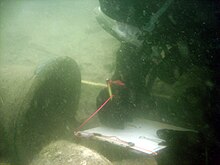
Back علم الآثار البحرية Arabic Морска археология Bulgarian সামুদ্রিক প্রত্নতত্ত্ব Bengali/Bangla Marinarkæologi Danish Meeresarchäologie German Arqueología marítima Spanish Meriarkeologia Finnish Archéologie maritime French ארכאולוגיה ימית HE समुद्री पुरातत्व Hindi
This article includes a list of general references, but it lacks sufficient corresponding inline citations. (September 2009) |

Maritime archaeology (also known as marine archaeology) is a discipline within archaeology as a whole that specifically studies human interaction with the sea,[1] lakes and rivers through the study of associated physical remains, be they vessels, shore-side facilities, port-related structures, cargoes, human remains and submerged landscapes.[2] A specialty within maritime archaeology is nautical archaeology, which studies ship construction and use.[3]
As with archaeology as a whole, maritime archaeology can be practised within the historical, industrial, or prehistoric periods.[4] An associated discipline, and again one that lies within archaeology itself, is underwater archaeology, which studies the past through any submerged remains be they of maritime interest or not. An example from the prehistoric era would be the remains of submerged settlements or deposits now lying under water despite having been dry land when sea levels were lower. The study of submerged aircraft lost in lakes, rivers or in the sea is an example from the historical, industrial or modern era. Another example are the remains of discovered and potential medieval bridges connecting the islands on the lake with the mainland.[5] Many specialist sub-disciplines within the broader maritime and underwater archaeological categories have emerged in recent years.[6]
Maritime archaeological sites often result from shipwrecks or sometimes seismic activity, and thus represent a moment in time rather than a slow deposition of material accumulated over a period of years, as is the case with port-related structures (such as piers, wharves, docks and jetties) where objects are lost or thrown off structures over extended periods of time.[7] This fact has led to shipwrecks often being described in the media and in popular accounts as 'time capsules'.
Archaeological material in the sea or in other underwater environments is typically subject to different factors than artifacts on land. However, as with terrestrial archaeology, what survives to be investigated by modern archaeologists can often be a tiny fraction of the material originally deposited. A feature of maritime archaeology is that despite all the material that is lost, there are occasional rare examples of substantial survival, from which a great deal can be learned, due to the difficulties often experienced in accessing the sites.
There are those in the archaeology community who see maritime archaeology as a separate discipline with its own concerns (such as shipwrecks) and requiring the specialized skills of the underwater archaeologist. Others value an integrated approach, stressing that nautical activity has economic and social links to communities on land and that archaeology is archaeology no matter where the study is conducted. All that is required is the mastering of skills specific to the environment in which the work occurs.
- ^ "Maritime, Offshore and Logistics Degree & Training Programs - EduMaritime". www.edumaritime.net.
- ^ "MARITIME ARCHAEOLOGY". Encyclopedia of Archaeology. Oxford: Elsevier Science & Technology, 2008. Retrieved 17 Jan 2013.
- ^ Muckelroy, K., "Maritime archaeology.", Cambridge University Press, 1978.
- ^ Renfrew, C., & Bahn, P., 1991, Archaeology, theories, methods and practice. Thames and Hudson, NY.
- ^ Janowski, Lukasz; Kubacka, Maria; Pydyn, Andrzej; Popek, Mateusz; Gajewski, Lukasz (2021). "From acoustics to underwater archaeology: Deep investigation of a shallow lake using high-resolution hydroacoustics—The case of Lake Lednica, Poland". Archaeometry. 63 (5): 1059–1080. doi:10.1111/arcm.12663.
- ^ Delgado, J. P., (ed.). 1997. British Museum Encyclopaedia of Underwater and Maritime Archaeology, British Museum Press, London
- ^ Withgott, Jay, Scott Brennan, J. 2007. Environment: the science behind the stories. 2nd ed. Pearson Benjamin Cummings, San Francisco.